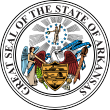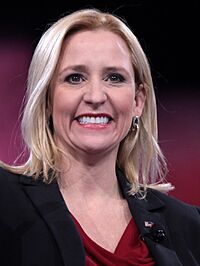Lieutenant Governor of Arkansas facts for kids
Quick facts for kids Lieutenant Governor of Arkansas |
|
|---|---|

|
|
| Government of Arkansas | |
| Seat | State Capitol, Little Rock, Arkansas |
| Term length | Four years, renewable once |
| Constituting instrument | Constitution of Arkansas |
| Inaugural holder | Calvin C. Bliss |
| Formation | April 18, 1864 |
The lieutenant governor of Arkansas is an important leader in the state government. This person helps lead the Arkansas Senate, which is part of the state's law-making group. If there's a tie vote in the Senate, the lieutenant governor gets to cast the deciding vote.
The lieutenant governor also steps in for the governor of Arkansas if the governor is out of the state. If the governor can no longer do their job, the lieutenant governor takes over as governor. This position is chosen by voters in a separate election from the governor. The current lieutenant governor is Leslie Rutledge, who started her term on January 10, 2023.
Contents
How the Job Started
The idea for a Lieutenant Governor in Arkansas began with the Sixth Amendment to the Arkansas Constitution in 1914. However, it took a while for someone to actually fill the job! The voters approved the amendment in 1914, but there was confusion about how many votes were needed for it to pass.
Later, in 1925, it was found that the rules for voting on such changes had been updated. This meant the 1914 amendment was indeed valid. So, in 1926, Harvey Parnell was elected as Arkansas's very first lieutenant governor.
Sometimes, a lieutenant governor starts their job in the middle of a term. This happens if the governor leaves office early. For example, when Governor Bill Clinton became President of the United States, his lieutenant governor, Jim Guy Tucker, became governor. Then, a special election was held to choose a new lieutenant governor. Later, when Governor Tucker left office, Mike Huckabee became governor, and Winthrop Paul Rockefeller was elected as the new lieutenant governor.
History of the Office
Arkansas didn't always have a lieutenant governor. During the American Civil War in 1864, a new state constitution was created. This new government included a lieutenant governor, who would be chosen by the people to serve four-year terms. Calvin C. Bliss was the first person to hold this office.
The job continued under the 1868 constitution but was removed in the 1874 constitution. Many years later, in 1914, people voted to bring the office back. Even though more people voted for it than against it, the Arkansas Supreme Court first said it didn't pass because of how the votes were counted. But in 1925, the court changed its mind, saying the office should be filled. That's when Harvey Parnell was elected.
At first, the lieutenant governor served for two years. But in 1986, the term was changed to four years. In 1992, rules were added to limit how many terms a person could serve. On January 10, 2023, Leslie Rutledge became the first woman to hold the office.
What the Lieutenant Governor Does
The lieutenant governor is one of seven main leaders in the Arkansas state government. Their most important jobs are:
- Leading the Arkansas Senate.
- Taking over as governor if the governor's office becomes empty.
- Acting as governor if the governor is temporarily out of the state.
The state's rules say that a lieutenant governor can serve a maximum of two terms. They earn an annual salary of $48,105.
List of Lieutenant Governors
| No. | Lieutenant Governor | Term in office | Party | Election | Governor | |||
|---|---|---|---|---|---|---|---|---|
| 1 |  |
Calvin C. Bliss (1823–1891) |
April 18, 1864 – July 2, 1868 (did not run) |
Republican | 1864 | Isaac Murphy | ||
| 2 |  |
James M. Johnson (1832–1913) |
July 2, 1868 – March 14, 1871 (resigned) |
Republican | 1868 | Powell Clayton (resigned March 17, 1871) |
||
| — | Vacant | March 14, 1871 – January 6, 1873 |
Office vacated by resignation |
|||||
| Ozra Amander Hadley | ||||||||
| 3 |  |
Volney V. Smith (1841–1897) |
January 6, 1873 – November 12, 1874 (office abolished) |
Republican | 1872 | Elisha Baxter | ||
| Office did not exist from November 12, 1874, to January 11, 1927 | ||||||||
| 4 |  |
Harvey Parnell (1880–1936) |
January 11, 1927 – March 14, 1928 (succeeded to governor) |
Democratic | 1926 | John Ellis Martineau (resigned March 14, 1928) |
||
| — | Vacant | March 4, 1928 – January 14, 1929 |
Office vacated by succession to governor |
Harvey Parnell | ||||
| 5 |  |
Lee Cazort (1887–1969) |
January 14, 1929 – January 12, 1931 (did not run) |
Democratic | 1928 | |||
| 6 |  |
Lawrence Elery Wilson (1884–1946) |
January 12, 1931 – January 10, 1933 (lost nomination) |
Democratic | 1930 | |||
| 7 |  |
Lee Cazort (1887–1969) |
January 10, 1933 – January 12, 1937 (did not run) |
Democratic | 1932 | Junius Marion Futrell | ||
| 1934 | ||||||||
| 8 |  |
Robert B. Bailey (1892–1957) |
January 12, 1937 – January 12, 1943 (did not run) |
Democratic | 1936 | Carl Edward Bailey | ||
| 1938 | ||||||||
| 1940 | Homer Martin Adkins | |||||||
| 9 |  |
James L. Shaver (1902–1985) |
January 12, 1943 – January 14, 1947 (did not run) |
Democratic | 1942 | |||
| 1944 | Benjamin Travis Laney | |||||||
| 10 |  |
Nathan Green Gordon (1916–2008) |
January 14, 1947 – January 10, 1967 (did not run) |
Democratic | 1946 | |||
| 1948 | Sid McMath | |||||||
| 1950 | ||||||||
| 1952 | Francis Cherry | |||||||
| 1954 | Orval Faubus | |||||||
| 1956 | ||||||||
| 1958 | ||||||||
| 1960 | ||||||||
| 1962 | ||||||||
| 1964 | ||||||||
| 11 |  |
Maurice Britt (1919–1995) |
January 10, 1967 – January 12, 1971 (did not run) |
Republican | 1966 | Winthrop Rockefeller | ||
| 1968 | ||||||||
| 12 |  |
Bob C. Riley (1924–1994) |
January 12, 1971 – January 3, 1975 (succeeded to governor) |
Democratic | 1970 | Dale Bumpers (resigned January 3, 1975) |
||
| 1972 | ||||||||
| — | Vacant | January 3, 1975 – January 14, 1975 |
Office vacated by succession to governor |
Bob C. Riley | ||||
| 13 |  |
Joe Purcell (1923–1987) |
January 14, 1975 – January 3, 1979 (succeeded to governor) |
Democratic | 1974 | David Pryor (resigned January 3, 1979) |
||
| 1976 | ||||||||
| — | Vacant | January 3, 1979 – January 9, 1979 |
Office vacated by succession to governor |
Joe Purcell | ||||
| 13 |  |
Joe Purcell (1923–1987) |
January 9, 1979 – January 19, 1981 (did not run) |
Democratic | 1978 | Bill Clinton | ||
| 14 |  |
Winston Bryant (b. 1938) |
January 19, 1981 – January 15, 1991 (did not run) |
Democratic | 1980 | Frank D. White | ||
| 1982 | Bill Clinton (resigned December 12, 1992) |
|||||||
| 1984 | ||||||||
| 1986 | ||||||||
| 15 |  |
Jim Guy Tucker (b. 1943) |
January 15, 1991 – December 12, 1992 (succeeded to governor) |
Democratic | 1990 | |||
| — | Vacant | December 12, 1992 – November 20, 1993 |
Office vacated by succession to governor |
Jim Guy Tucker (resigned July 15, 1996) |
||||
| 16 |  |
Mike Huckabee (b. 1955) |
November 20, 1993 – July 15, 1996 (succeeded to governor) |
Republican | 1993 (special) |
|||
| 1994 | ||||||||
| — | Vacant | July 15, 1996 – November 19, 1996 |
Office vacated by succession to governor |
Mike Huckabee | ||||
| 17 |  |
Winthrop Paul Rockefeller (1948–2006) |
November 19, 1996 – July 16, 2006 (died in office) |
Republican | 1996 (special) |
|||
| 1998 | ||||||||
| 2002 | ||||||||
| — | Vacant | July 16, 2006 – January 9, 2007 |
Office vacated by death |
|||||
| 18 |  |
Bill Halter (b. 1960) |
January 9, 2007 – January 11, 2011 (did not run) |
Democratic | 2006 | Mike Beebe | ||
| 19 |  |
Mark Darr (b. 1973) |
January 11, 2011 – February 1, 2014 (resigned) |
Republican | 2010 | |||
| — | Vacant | February 1, 2014 – January 13, 2015 |
Office vacated by resignation |
|||||
| 20 |  |
Tim Griffin (b. 1968) |
January 13, 2015 – January 10, 2023 (term-limited) |
Republican | 2014 | Asa Hutchinson | ||
| 2018 | ||||||||
| 21 |  |
Leslie Rutledge (b. 1976) |
January 10, 2023 – Incumbent |
Republican | 2022 | Sarah Huckabee Sanders | ||


